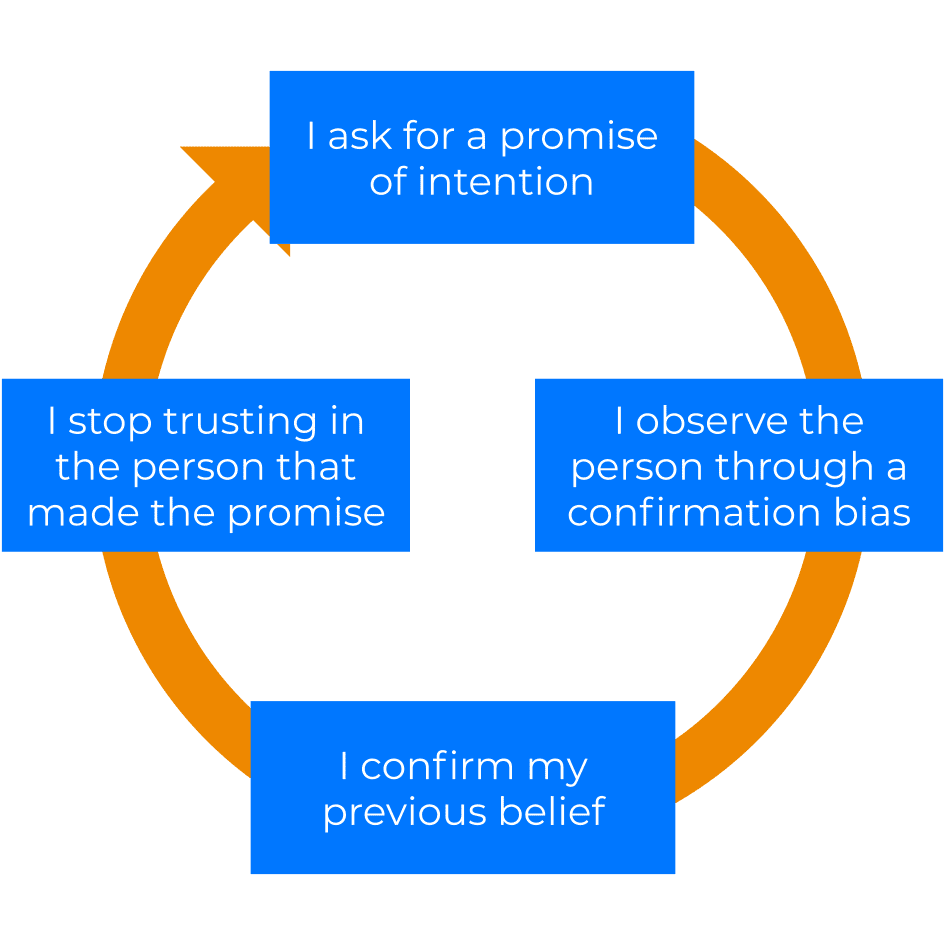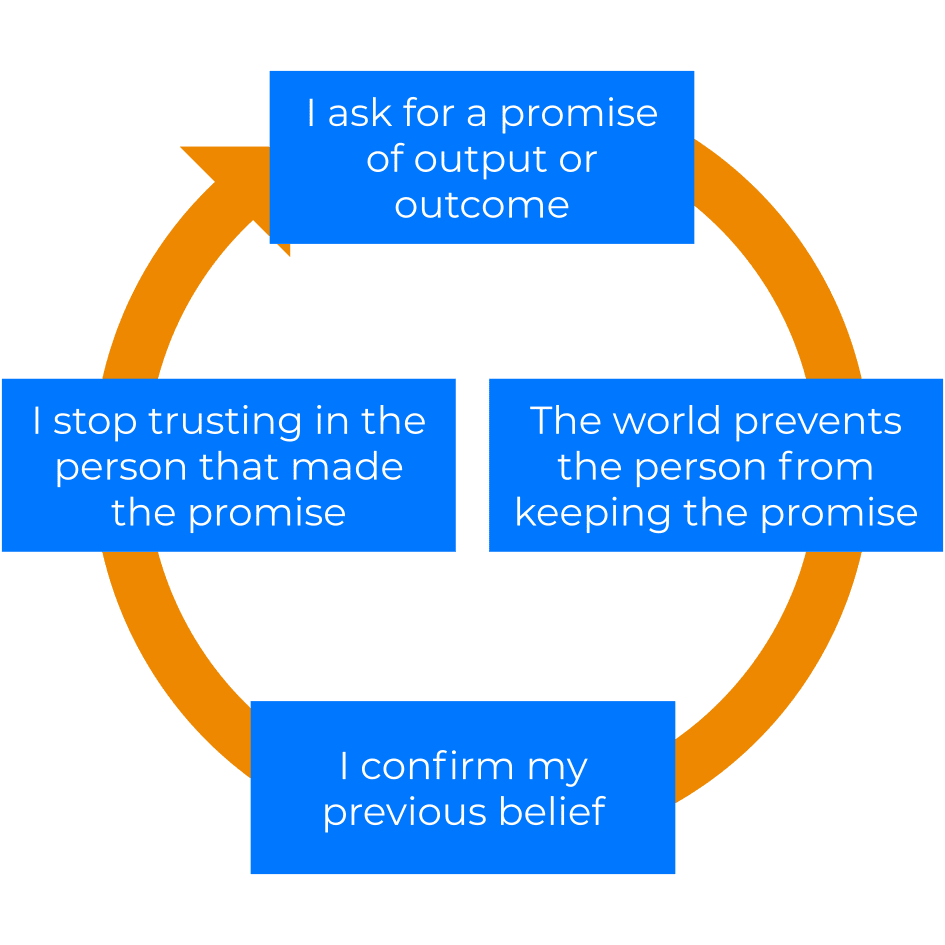Common sense preaches and research has already shown that mutual trust is critical to collaboration in teams and organizations. But how the trust phenomenon really happens and especially how trust breakdown takes place is what I will explore here.
When I work with teams and organizations helping to restore minimum levels of trust and quality in relationships, I see many of my strategies falling apart. It is as if once lost, trust can no longer be regained.
But why is there a breach of trust?
One of the easy reasons to identify is when some promises made are not kept, and then we lose trust in each other. It also happens when promises are not made explicitly between the two parties, but rather one party imagines or infers promises from specific signs or confusing communication.
To better understand how promises work, let’s break them down into four categories. Promises can be about:
- Intent
- Input (applied energy)
- Output (specific results)
- Outcome (impact in the world)
Note to blog readers: We use the word “agreement” a lot in the articles about self-management and the social technology O2. Here we choose the word “promise”, as it is more closely related to the breach of trust. You can understand an agreement as a set of multiple promises made by multiple people in a coordinated and explicit manner.
We promise intent
It is very common to say something along the lines of:
I commit to being transparent about what I am working on and how I am prioritizing my work as well as being open to dialogue and negotiation.
Nice promise, right? It makes a lot of sense when it’s part of an agreement between people working on the same team. That is, there is an equivalence, because everyone is promising the same thing to the group.
It’s easy to make that kind of promise, and in self-management using O2, we end up using this type a lot when someone is filling a role (commits to working to express a specific purpose and to meet the expectations that are outlined in the accountabilities). It’s a very subjective kind of promise.
To know if it has been fulfilled, we need to use a lot of judgment, which is always loaded with cognitive biases. So when trust is high, that promise is very likely to be evaluated as, “OK, he kept his promise”. When trust is already broken or worn out, then the confirmation bias works against it, and the chance of the person assessing that his or her colleague has failed to deliver on the promise is very high.
We promise input (applying energy)
This is a kind of promise more specific and observable than the previous one. Here we can say something along the lines of:
I will spend tomorrow afternoon working on this project.
Or:
I will dedicate 5 hours a week to this role
In theory we have great control (especially in self-managed organizations) over how we use our time. So it shouldn’t be so hard to keep the promise. But the world is VUCA (volatile, uncertain, complex and ambiguous), and often unexpected situations arise that prevent our plans from coming true, including the dedication of energy to a project or role.
To avoid a breach of trust in making such promises, we can dilute it with a promise of intent. Something like:
My intention is to spend all day tomorrow focused on this activity.
This opens space for multiple interpretations of what will happen.
You may have already encountered the following reaction: Ah, but I want or need a certainty that you will work on it that day! Ok, in this case one possible way is for the person to better disclose their needs, reasons and work together to increase the chances of an input promise being fulfilled or having contingency plans. Choose that path or risk breaking trust.
We promise output (specific results)
This kind of promise is one of the most common in traditional organizations. Almost every day you should hear:
I made a commitment to deliver the document by Tuesday.
Or:
I promised my boss that I will finish this report today.
This kind of promise usually generates a lot of anxiety, stress and overtime. In many cases people are pressured or even coerced to make such promises by customers or managers.
Once again the VUCA world increases the chances of a broken promise. Except for repetitive jobs and dull routines, reality is often surprising and deadlines may not be met. If you are still unsure how to handle this, I recommend the text: Do it like Waze, don’t give deadlines.
We promise outcome (impact in the world)
If the former type is strongly influenced by the VUCA world, this is even more so. For example:
I am committed to selling 80% of workshop tickets.
Or:
I guarantee that I will double the department revenues in six months.
Notice. You are re not just promising to work to sell as many tickets as possible, but committing to financial results that depends on macroeconomic factors and many other things. For me, it’s almost like betting relationship quality (trust) on a casino.
Common reaction: Ah, but if we do not reach that result, our organization is at risk.
My answer: Yes, sure, but if we do not reach that result with the promise of outcome, besides being financially screwed, we will be corroding our trust.
Other times we try to force outcome promises because we have no trust in people’s skills and capacities. But certainly it is not with such a promise that trust will improve. Forcing outcomes on people will only make they accept anything, even ignoring the consequences of a VUCA world.
Types of trust and breakdown cycles
There are at least two types of trust: trust in intentions and trust in skills (or capacities). The first type is fundamental. It is impossible to work in a team without it. The second is also important, but it is more contextual. I can trust that a person is competent in X, but not in Y.
There are feedback loops that reinforce themselves, increasing or degrading the level of trust. Below I have drawn two schemes that show how they work and why it is so difficult to restore trust when it is broken.

Trust in intentions breakdown cycle

Trust in skills breakdown cycle
To break these cycles and change reality, we need to act in different ways on them.
To restore trust in intentions, we must work with the present cognitive biases, especially those related to confirmation bias. In addition, we must work on empathic listening between the two parties, so we make room for new promises of intent to be heard and hope for a fresh start in the relationship.
In order to recover trust in skills, we can add another strategy, bringing the following question to the conversation: given that the world is VUCA, how can we work with the minimum amount of output and outcome promises?
I have no definitive or detailed answers to the details of how to act within the lines I have quoted or even if there is any precedence in these types of trust.
We are learning at Target Teal, and we use this blog to share the insights that come from our work. Leave your comment or reflection below, we will be happy to answer it.
Translated by Tanya Stergiou






Leave A Comment